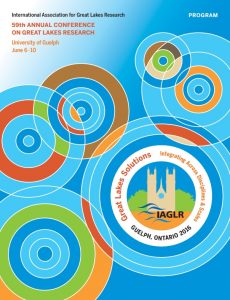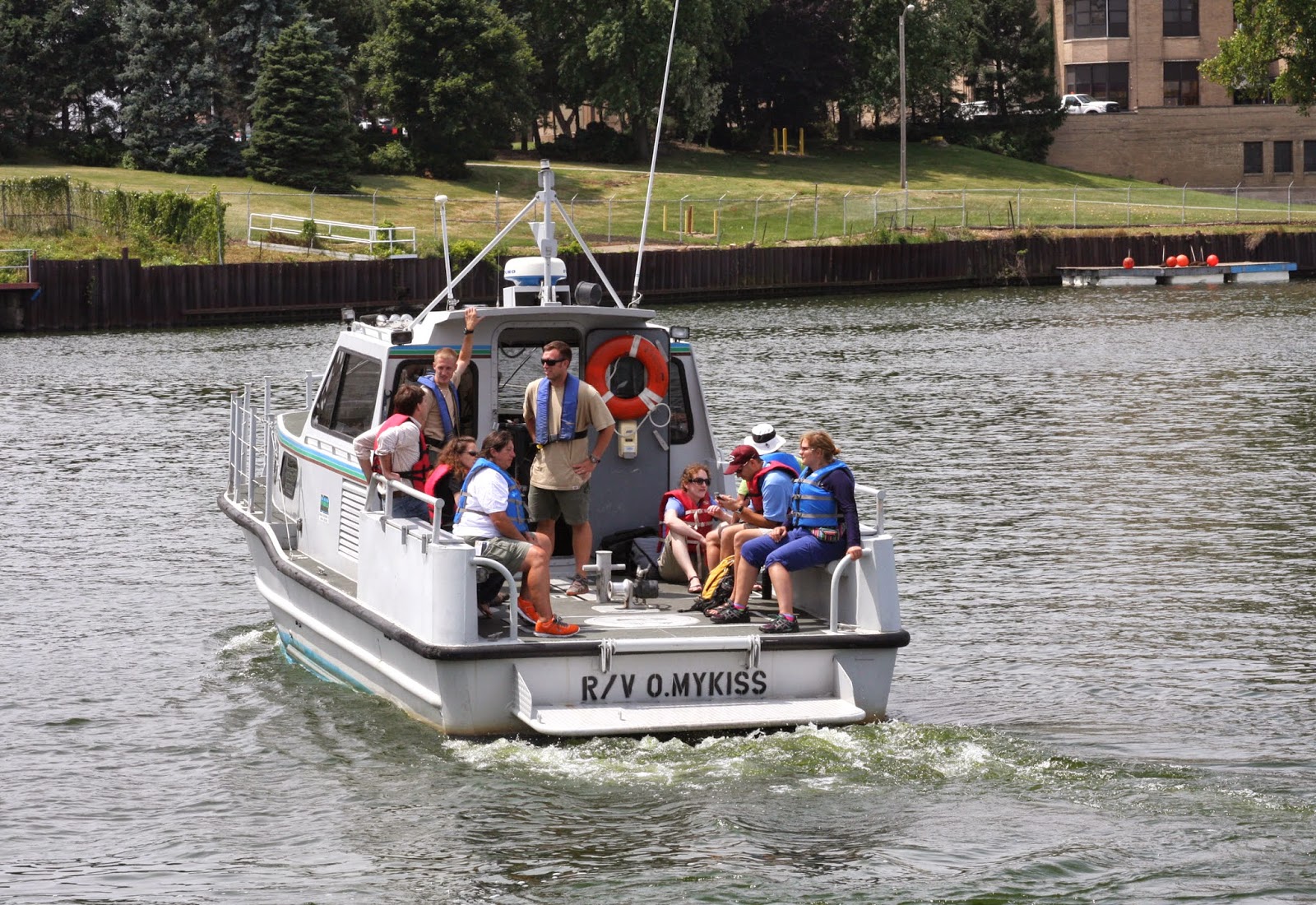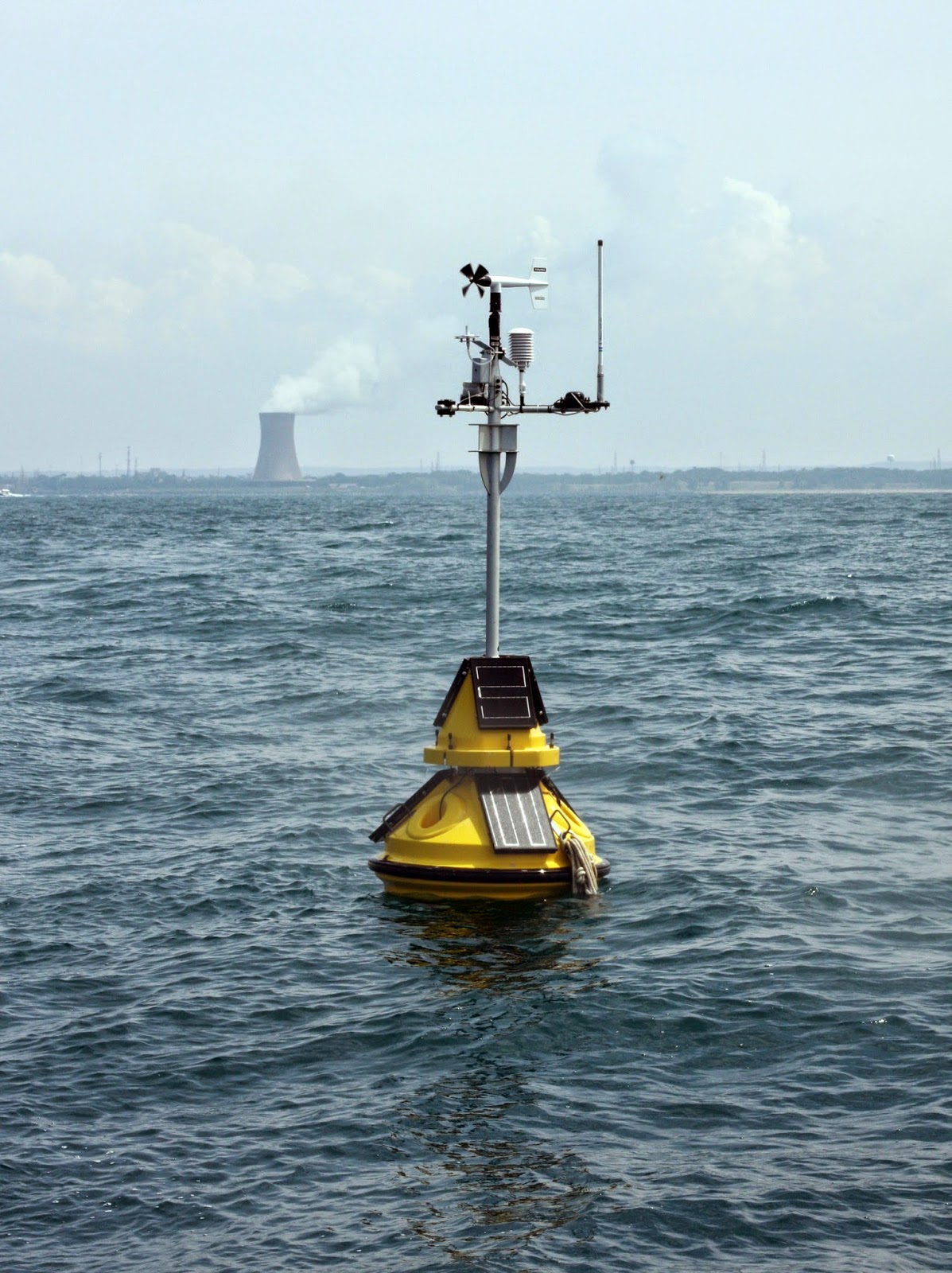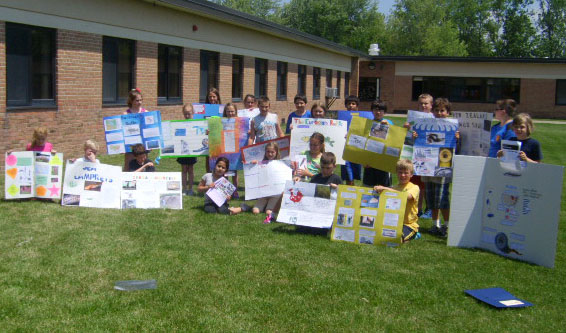June 9th, 2016 by IISG
IISG Associate Director of Research Tomas Höök has been elected president of the International Association for Great Lakes Research (IAGLR) for the 2016-2017 term. IAGLR, which got its start in the 1950s, is an organization made up of scientists conducting research of large lakes throughout the world.
Höök, currently the vice president, has been member of the organization since his days in graduate school at the University of Michigan.
“We try to keep IAGLR functioning smoothly and facilitating exchange of research information regarding large lakes of the world,” said Höök. That said, we are also exploring opportunities to grow IAGLR. Specifically, we are seeking to hold meetings in addition to the annual conference on Great Lakes research. Ultimately, we hope to better connect Great Lakes researchers with environmental managers, communicators, and educators.”
This year’s IAG LR conference was held in Guelph, Ontario from June 6-10 and several IISG researchers presented and chaired sessions.
LR conference was held in Guelph, Ontario from June 6-10 and several IISG researchers presented and chaired sessions.
Jay Beugly, aquaculture ecology specialist, presented on the usefulness real-time buoy data provides to a variety of stakeholders, ranging from recreational boaters to weather service professionals in the southern basin of Lake Michigan. Fellow IISG collaborators Carolyn Foley, Angela Archer, and Tomas Höök, along with Cary Troy of Purdue University, and Ed Verhamme, of LimnoTech were also part of the project.
A presentation by Community Outreach Specialist Kristin TePas shared best management practices for setting up and conducting science-based videocalls with K-12 classrooms. She also co-chaired a session on Great Lakes education and outreach.
Carolyn Foley, assistant research coordinator, shared her work on the contribution and effects of different terrestrial nutrient sources on the diets of small-bodied fishes in nearshore Lake Michigan.
Paris Collingsworth, Great Lakes ecosystem specialist, presented findings from research derived from two programs that monitor phosphorus and chlorophyll in Lake Erie. The goal was to paint a more complete picture of lower food web level dynamics. Collingsworth also co-chaired a session dedicated to ecological connections in Lake Michigan.
In addition to contributing to eight presented projects, Tomas Höök a co-chaired a session on the global stressors on large-lake ecosystems.
July 9th, 2015 by iisg_superadmin
Fifteen educators from six states surrounding the Great Lakes are getting the chance to be scientists in the field – or rather water – during this year’s Shipboard Science Workshop in Lake Michigan on the Lake Guardian, the U.S. EPA Great Lakes National Program Office (GLNPO) research vessel. The annual workshop will take place the week of July 12-18 and is hosted by Illinois-Indiana Sea Grant (IISG).
The teachers, alongside four research scientists from U.S. EPA GLNPO, University of Wisconsin-Milwaukee and Loyola University Chicago, will take part in sampling to evaluate the presence of microplastics and assess the impact of aquatic invasive species, especially zebra and quagga mussels.
And as part of the workshop, teachers will be able to analyze the samples in on-board laboratories. The hope is that the teachers will take their experiences back to the classroom and inspire their own students to want to do scientific exploration of the Great Lakes.
This workshop is IISG community outreach specialist Kristin TePas’ fifth, and she never tires of seeing teachers learning and researching in the field.
“Aside from the concept of educators working side by side with scientists collecting and analyzing data, these cruises have a lot of variation from year to year because the scientists change and thus the focus of research taking place is often different,” TePas said.
“I always look forward to watching how the educators take to the whole experience. They come on rather green and leave at the end of the week looking like they have always lived on the ship and working like a well-oiled machine with the field sampling and then analyzing in the lab.”
Bonnie Sansenbaugher, a teacher from last year’s workshop on Lake Erie, made sure she took advantage of the experience and didn’t return to her classroom empty-handed.
“As we were covering the curriculum portion of the workshop I was making notes of which lessons I will use for which class and which month I will cover that topic,” she wrote on the Center for Great Lakes Literacy blog.
On July 12, the ship will set sail from Milwaukee, with stops in Manitowoc, WI on the 14th, and Frankfort, MI on the 16th. This year, four educators from Illinois and two from Indiana will be making the trip.
Teachers will be tweeting and blogging on this cruise as well. Look for them on twitter at #lakeguardian and on the Teacher Features page on the CGLL website.
Each year a different lake within the world’s largest freshwater system goes under the microscope for this kind of intensive look-see. Next year it’s Lake Superior’s turn.
This workshop is funded through the Great Lakes Restoration Initiative. Wisconsin Sea Grant was a key partner in planning this year’s event.
-Abigail Bobrow
June 3rd, 2015 by iisg_superadmin
Another school year is coming to a close, and teachers across the country are beginning to pack up their classrooms for the summer. Books are being packed away, wall decorations are coming down, and classroom plants and animals are moving to a new home. And where that new home is can have large and lasting environmental impacts.
Common classroom pets like goldfish, bullfrogs, and red-eared slider turtles can become invasive if released into local rivers, lakes, and ponds. Many aquarium plants also pose a threat to nearby aquatic habitats. These invaders can crowd out native species, degrade water quality, introduce diseases, and limit recreation. Once established, aquatic invasive species are extremely difficult to control—Florida alone spends millions each year trying to control the aquarium plant hydrilla.
Teachers and students can help protect our waterways from the harmful effects of aquatic invasive species with a few simple steps. While you’re in the market for a classroom pet, look for native and non-invasive species. Knowing the scientific names will make this easier.
When the time comes to dispose of plants, seal them in a plastic bag and throw them in the trash. Fish, reptiles, and other animals should be returned to the seller or given to a friend or fellow teacher who has pledged not to release unwanted pets. If a new home can’t be found, ask a veterinarian about other options. And be sure to sterilize any water before pouring it down the toilet or sink.
Learn more about aquatic invasive species and what you can do to curb their spread at www.TakeAim.org.
November 24th, 2014 by iisg_superadmin
Several IISG staff members were in Grand Rapids, MI earlier this month to share some of our education resources and curricula during the Great Lakes Place-based Education Conference. For Allison Neubauer, the experience had an unexpected twist.
Stewardship and place-based education are nothing new to us educators at Illinois-Indiana Sea Grant. In fact, the IISG education team has been leading efforts in these initiatives throughout southern Lake Michigan communities for years. For this reason, going into the conference, I thought it was a great opportunity for us to share our models of stewardship and place-based education. I didn’t plan on gaining much insight into how and why these objectives were critical. Boy, was I wrong.
IISG undoubtedly has an arsenal of exemplary stewardship models, and a jam-packed room of eager educators at our Friday afternoon session was an indication of their desire to hear how we’ve extended learning beyond classrooms and into communities.
But as much as I enjoyed sharing our examples of student stewardship as a means of combatting invasive species, promoting proper disposal of unwanted medication, and teaching about benefits and risks of fish consumption, the best part of the conference was actually hearing others share their stories.
The opening keynote address by Kim Rowland, a middle school science teacher, detailed how her students have been able to use their surrounding environment in Grand Rapids as a resource for exploration and learning. What was most captivating and exciting to hear was how this time spent investigating the outdoors was a way to reach students that are not typically high academic achievers. Kim told us about a particular student who was always getting in trouble—not wanting to come to school, and certainly not excited about learning. Though she had not anticipated this, venturing out to the stream on school property transformed him into the most enthusiastic student of the group. In fact, this student was now so interested in collecting samples that he waded even further into the stream, thus giving Kim a very fitting title for her presentation: “Getting Your Feet Wet and Allowing Water to Flood Your Boots.”
This was a great way to kick-off the conference. It really impressed upon me that place-based education should not be considered a luxury, or something that only all-star teachers are doing. Every student—from urban to rural, high achieving to special needs—must be exposed to learning outside the classroom. School should not take place in isolation, between the same four walls everyday. There is immense value in connecting students with their communities and surrounding environments as a means to enhance learning and civic understanding.
September 25th, 2014 by iisg_superadmin
 Charleston, IL may be hundreds of miles from where the R/V Lake Guardian was collecting samples in Lake Erie earlier this week, but that didn’t stop a group of sixth graders from taking a tour of the U.S. EPA vessel. From the comfort of their classroom, more than 60 students and teachers watched as EPA researcher Beth Hinchey Malloy talked about living and working on a boat and showed them around.
Charleston, IL may be hundreds of miles from where the R/V Lake Guardian was collecting samples in Lake Erie earlier this week, but that didn’t stop a group of sixth graders from taking a tour of the U.S. EPA vessel. From the comfort of their classroom, more than 60 students and teachers watched as EPA researcher Beth Hinchey Malloy talked about living and working on a boat and showed them around.
 The tour started, of course, on the ship’s deck and quickly moved inside to the labs, where scientists took a break from processing samples to explain how studying bug populations helps researchers judge the health of aquatic ecosystems. From there it was on to the galley to see what’s for lunch and up to the bridge to chat with the captain.
The tour started, of course, on the ship’s deck and quickly moved inside to the labs, where scientists took a break from processing samples to explain how studying bug populations helps researchers judge the health of aquatic ecosystems. From there it was on to the galley to see what’s for lunch and up to the bridge to chat with the captain.

And the students had more than a few questions, particularly for the captain—Is it easy to drive the boat? How can you tell how deep the water is? Where does the Lake Guardian go?
Students also got a sneak peak at the type of equipment they will use later this year to collect data on water characteristics like dissolved oxygen, conductivity, and pH. Their teacher, Pamela Evans, is one of several scheduled to use the Hydrolab to make science class more hands-on this year.
The event ended after a jam-packed 30 minutes because another class was waiting on deck to take the tour. In fact, eight classes across the Great Lakes region got a first-hand look at the Lake Guardian this week. And this is just the beginning. The research vessel will soon dock for the winter, but video chats with EPA scientists will continue throughout the school year.
The video chats and equipment loan program are all part of efforts by IISG and the EPA Great Lakes National Program Office to boost Great Lakes education. Teachers were introduced to the programs, along with other classroom resources, during the annual Shipboard Science workshop.
September 16th, 2014 by iisg_superadmin
Our education team is at it again! Allison Neubauer wrote in with this exciting announcement:
 Teachers across the Great Lakes region—have we got a treat for you! You can now explore creative projects from all-star educators to spark new ideas and read important tips for getting your students involved in the effort to “nab” local aquatic invaders.
Teachers across the Great Lakes region—have we got a treat for you! You can now explore creative projects from all-star educators to spark new ideas and read important tips for getting your students involved in the effort to “nab” local aquatic invaders.
The IISG education team has been working hard to compile model projects that successfully tie together AIS education and community stewardship. Our revamped Nab the Aquatic Invader! website will help you up your game—and the new-and-improved Top Desk Administrator is your one-stop-shop for project ideas.
Community stewardship projects like the ones highlighted here are an exceptional tool for pushing students beyond rote memorization and providing them with an opportunity to apply their knowledge in ways that have positive impacts on their communities.
Preview outstanding examples of student work, ranging from fun informational activity books to catchy musical compilations. When you’re done perusing, read the summary reports written by the teachers responsible for these successful activities for information on how to plan and implement similar projects in your own classroom.
The Nab the Aquatic Invader! website is the place for the latest and greatest invasive species project models, information, and activities.
August 15th, 2014 by iisg_superadmin
 Fourteen teachers from Illinois and Indiana are hard at work developing new science lessons that incorporate real-time data from the Michigan City buoy after a training workshop held last week at Purdue North Central.
Fourteen teachers from Illinois and Indiana are hard at work developing new science lessons that incorporate real-time data from the Michigan City buoy after a training workshop held last week at Purdue North Central.
During the day-long workshop, IISG’s education and research teams, along with Purdue University’s Cary Troy
, introduced teachers to the environmental monitoring buoy, the data it collects, and how researchers are using the data to better understand the nearshore waters of Lake Michigan.
 The highlight of the workshop for many was the boat ride four miles into Lake Michigan to see the buoy first-hand—in smaller groups due to the size of the boat. The trips also gave teachers the opportunity to talk more with researchers and staff from the Indiana Department of Natural Resources(DNR) about the buoy and other data collection methods used to monitor fisheries, understand lake dynamics, and improve water safety.
The highlight of the workshop for many was the boat ride four miles into Lake Michigan to see the buoy first-hand—in smaller groups due to the size of the boat. The trips also gave teachers the opportunity to talk more with researchers and staff from the Indiana Department of Natural Resources(DNR) about the buoy and other data collection methods used to monitor fisheries, understand lake dynamics, and improve water safety.
The teachers will work together to develop at least six curriculum activities that improve STEM education—science, technology, engineering, and math—and boost understanding of Great Lakes issues. These won’t be complete till early next year, but the teachers already have big ideas for how to integrate the buoy data into their classrooms.
Several hope to use information on wind speed and water currents to improve their weather units. Others plan to use data collected by the buoy’s thermistor chain, which measures temperatures at different depths, to pinpoint the likely habitats of specific fish species and determine whether invaders like Asian carp could make a home in Lake Michigan. Some even expressed interest in having students compare buoy data with environmental characteristics collected on land to better understand solar radiation and seasonal changes.
The final lesson plans will be available on the IISG website.
Funding for the workshop was provided in part by the Indiana DNR Lake Michigan Coastal Program. Special thanks to the DNR staff at the Michigan City field office for taking the participants out on the lake.
August 12th, 2014 by iisg_superadmin
Illinois teacher Carol Schnaiter has big plans for her classes at Amboy Central School. Carol was one of 14 teachers to participate in IISG’s B-WET workshop last year. And this summer, she spent two weeks in the Gulf of Mexico aboard the NOAA research vessel Oregon II. Carol wrote in to tell us about her experiences at both, how they have already shaped her curriculum, and what she has planned for her students this year.
“I am constantly looking for workshops, classes, and events that I can attend and bring what I learned back to my class. Each adventure adds to our classroom and allows the students to learn something new.
 I was very excited when I was selected for the B-WET workshop in June of 2013. After the workshop, I added an entire unit on invasive species in the Great Lakes area for the 4th graders and another unit on restoration for the 3rd graders, plus I expanded the watershed unit I was teaching to the third graders. At the end of the units, I invited a guest speaker from the Amboy Marsh, Greg Hunter, to speak to all my classes about the Amboy Marsh and invasive species in our area. We then went to the Amboy Marsh, where the students pulled the invasive Garlic Mustard plant and cleaned away brush. The staff also arranged for guest speakers to talk about turtles, birds, and plants and gave a walking tour of the marsh. My colleagues and I are hoping to continue working with Amboy Marsh when we do our invasive species unit and our restoration unit each year.
I was very excited when I was selected for the B-WET workshop in June of 2013. After the workshop, I added an entire unit on invasive species in the Great Lakes area for the 4th graders and another unit on restoration for the 3rd graders, plus I expanded the watershed unit I was teaching to the third graders. At the end of the units, I invited a guest speaker from the Amboy Marsh, Greg Hunter, to speak to all my classes about the Amboy Marsh and invasive species in our area. We then went to the Amboy Marsh, where the students pulled the invasive Garlic Mustard plant and cleaned away brush. The staff also arranged for guest speakers to talk about turtles, birds, and plants and gave a walking tour of the marsh. My colleagues and I are hoping to continue working with Amboy Marsh when we do our invasive species unit and our restoration unit each year.
 The students loved learning about the invasive species! We used the cards from the Sea Grant curricula and played games, such as Beat the Barriers. The students also did research on the various species and used the watch cards. When Mr. Hunter came in to speak, the students had background information on invasive species and were able to connect with what he was discussing.
The students loved learning about the invasive species! We used the cards from the Sea Grant curricula and played games, such as Beat the Barriers. The students also did research on the various species and used the watch cards. When Mr. Hunter came in to speak, the students had background information on invasive species and were able to connect with what he was discussing.
This summer, I took part in the NOAA Teacher at Sea Program in the Gulf of Mexico. While on the ship, I worked with NOAA scientists and the crew to learn about the Gulf ecosystems first-hand and watch real science in action. I was on the midnight-to-noon shift for 16 days. We traveled to “stations” across the Gulf where we dropped the trawling net, the bongo nets, and the CTD (conductivity, temperature, and depth) sensors as part of the Groundfish Survey. Once the nets were brought up, we would count, measure, weigh, and record the sex of all the species. Our main objective was to collect information and send it to federal agencies that used it to set the shrimp season and catch limits.
 As a result of this experience, I am working on adding more information to our invasive species unit and creating another unit that will have the students trace the water from the Great Lakes watershed to the Gulf of Mexico. We will be following the NOAA Ship Oregon II as they go out for the fall Groundfish Survey and adding that information to the data collected while I was aboard this summer. We will be watching the water’s oxygen levels as the ship travels across the Gulf and will try to figure out what might be the cause of any changes.
As a result of this experience, I am working on adding more information to our invasive species unit and creating another unit that will have the students trace the water from the Great Lakes watershed to the Gulf of Mexico. We will be following the NOAA Ship Oregon II as they go out for the fall Groundfish Survey and adding that information to the data collected while I was aboard this summer. We will be watching the water’s oxygen levels as the ship travels across the Gulf and will try to figure out what might be the cause of any changes.
Tying both the B-WET workshop and my experience on a working research ship together will allow the students to see how everyday science is touching our lives.”
July 10th, 2014 by iisg_superadmin
It’s day four of the Shipboard and Shoreline Science Workshop, and teachers from across the Great Lakes region are hard at work conducting field experiments alongside researchers aboard the EPA R/V Lake Guardian. The group was in Lake Erie’s Presque Isle Bay yesterday collecting water samples and hunting for invasive species. Their work, along with some of the researchers and participants, was featured on WICU 12 Erie.
 “I’m going to bring this back to my classroom,” Chad Solomon, a teacher at Chicago’s Whitney M. Young Magnet High School told WICU. “We live in Chicago, but very rarely do kids actually get to the lake. I am going to be bringing this experience back to them.”
“I’m going to bring this back to my classroom,” Chad Solomon, a teacher at Chicago’s Whitney M. Young Magnet High School told WICU. “We live in Chicago, but very rarely do kids actually get to the lake. I am going to be bringing this experience back to them.”
Joining the teachers at this shoreline stop and throughout the research cruise is IISG’s Kristin TePas. Kristin coordinates the annual teacher workshop, held each year on a different lake, for the Center for Great Lakes Literacy and the EPA Great Lakes National Program Office.
Sea Grant-funded researchers Sam Mason and Steve Mauro were also on board sampling for emerging pollutants like plastic and pharmaceuticals. You can learn more about Mason’s research in Lake Erie and across the Great Lakes in the latest issue of UpClose. And watch for the next edition later this month to hear from Mauro directly about his work on the Lake Guardian.
*Photo taken during the 2010 cruise on Lake Michigan
 LR conference was held in Guelph, Ontario from June 6-10 and several IISG researchers presented and chaired sessions.
LR conference was held in Guelph, Ontario from June 6-10 and several IISG researchers presented and chaired sessions.













